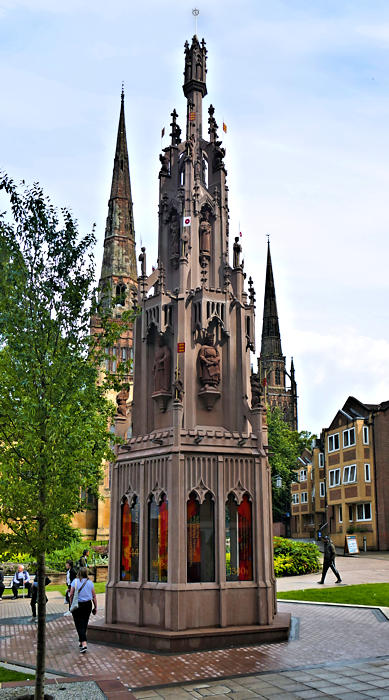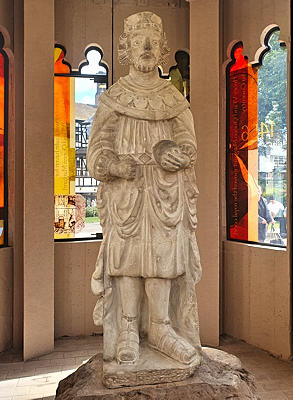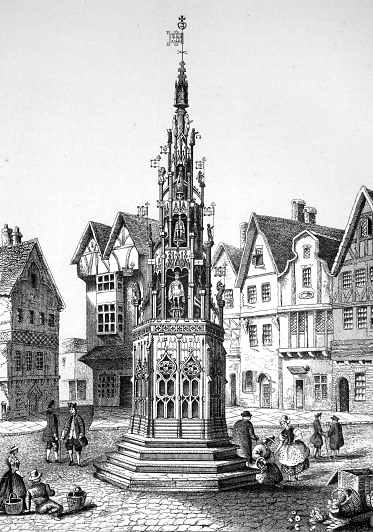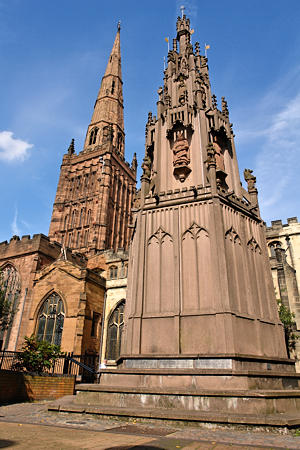|
Index...
|

 n the 13th July 2023 the Cross pictured here was unveiled. It is a slight re-fashioning of the replica completed in 1976, with the addition of attractive coloured windows inserted into the arcades of the base section telling the story of early Coventry and King Henry VI, who was featured among the statues adorning the Cross built nearly 500 years ago, and upon which design this one is based. This newly unveiled Cross is relocated only about 35 metres north of the 16th century Cross's location (see the map extract below). In ancient times this was where Broadgate met Cross Cheaping, near Spicer Stoke, a very short row which led through from Broadgate to Butcher Row and Holy Trinity Church.
n the 13th July 2023 the Cross pictured here was unveiled. It is a slight re-fashioning of the replica completed in 1976, with the addition of attractive coloured windows inserted into the arcades of the base section telling the story of early Coventry and King Henry VI, who was featured among the statues adorning the Cross built nearly 500 years ago, and upon which design this one is based. This newly unveiled Cross is relocated only about 35 metres north of the 16th century Cross's location (see the map extract below). In ancient times this was where Broadgate met Cross Cheaping, near Spicer Stoke, a very short row which led through from Broadgate to Butcher Row and Holy Trinity Church.

Inside the base of our new Cross is a replica of the original statue of King Henry VI. It has been 3D-printed by scanning the remaining statue held in the Herbert Art Gallery and Museum. The new window inserts give passers by a glimpse of this novel addition to the Cross.
In my opinion, another fortunate aspect of this new location, besides the fact that it's closer to where the original stood, is that a rather pleasant grouping can now be made in photographs, taking in the Cross along with Coventry's two major spires, evident in the photo to the left.
The building of a replica Cross was proposed long before WW2. However, unforeseen circumstances forced delay, and the modern Cross, including sculptures designed by Coventry artist George Wagstaffe, and funded by the Coventry Boy Foundation, was finally unveiled on the 23rd April 1976. While being an admirable copy, the modern version of the Coventry Cross cannot compete for splendour with the one for which Coventry was famed from Tudor through to Georgian times.
It's most probable that a Cross stood in that place since the 13th century, a structure commonly used to denote a market-place in medieval times. The first actual record for the building of a new Cross, however, was on 1st July 1423 when the Mayor, Henry Peyto, and his brethren ordained that a new Cross should be built. Later that year £50 was sanctioned for its erection, plus a personal contribution from the Mayor himself.

It was quite a substantial structure standing on eight pillars, but this was not the Cross about which so many superlatives were spoken. Within a century the 1423 Cross was rather the worse for wear, and by 1506 discussions were beginning as to its replacement.
Sir William Hollis, who had been born in Stoke in Coventry around 1471, and went on to become Lord Mayor of London in 1539, died on the 13th October 1542. In his will made the previous year he'd left £200 toward the building of a new Cross, which was begun in the year he died, and by 1544 the Cross, pictured in an engraving on the right, was completed.
This new Coventry Cross stood 57 feet high, hexagonal in cross-section, with sides 7 feet wide at its base, and standing on four steps, the bottom of which was 20 feet across. It was decorated with eighteen statues of kings and saints, some taken from Whitefriars. As well as being brightly painted, the Cross was also covered with much gold, such that it was said at the time that on a sunny day, people could not bear to look directly at it!
Visitors of note wrote enthusiastically about its fame and beauty, but all good things must come to an end and after two glorious centuries decay was once more setting in. In 1753 and 1755 the top two stages were removed to avoid danger of collapse. By 1771 it was declared to be in too ruinous a state to retain, and demolition was finally authorised. The remains stood for a short while longer - at least until after 1778 when a visitor to Coventry wrote sadly that the decayed Cross "... has no longer anything to please", before being totally removed and its parts reused.
Below is an 1851 map which shows the original site of the ancient Coventry Cross. Clicking or tapping the map will reveal the location on a modern aerial view of Broadgate (courtesy of Google Maps). Note how much wider High Street is at its Broadgate end since 1851 - this was widened around 1930 when the National Provincial (now Nat West) and Lloyds banks were built, set much farther back.
Historical facts about the ancient Cross taken from David McGrory's 2003 book "A History of Coventry".
 he history of proposals for reproductions of the Coventry Cross is interesting in itself. The first seeds of the idea were sown at a meeting of freemen at St. Mary's Hall on Monday 26th June 1871, reported by the Coventry Herald, which was held to discuss a suitable memorial to one of our city's great benefactors, Sir Thomas White. Once this plan became public knowledge the Coventry Standard, on September 15th, reported a proposal that it might be a good idea for such a monument to take the form of a reproduction Coventry Cross, with a statue of Sir Thomas White being prominent in its design.
he history of proposals for reproductions of the Coventry Cross is interesting in itself. The first seeds of the idea were sown at a meeting of freemen at St. Mary's Hall on Monday 26th June 1871, reported by the Coventry Herald, which was held to discuss a suitable memorial to one of our city's great benefactors, Sir Thomas White. Once this plan became public knowledge the Coventry Standard, on September 15th, reported a proposal that it might be a good idea for such a monument to take the form of a reproduction Coventry Cross, with a statue of Sir Thomas White being prominent in its design.
However, despite a group of Freemen's Trustees meeting regularly to raise funds for such a memorial, by 1875 things had gone quiet. In October 1878, however, the meetings were revived, reporting that although they had so far raised £177, they would probably have to multiply that by ten in order that something as substantial as a Coventry Cross replica could be built. On the 18th October 1878 another meeting at St. Mary's Hall resolved that "... the Memorial shall take the form of the Old Coventry Cross, and be placed in Broadgate, Sir Thomas White taking principal position...", and in November the following year the proposal for a Cross of similar dimensions to the original was approved, although the question of its location, due to possible interference with traffic in Broadgate, was also raised. One speaker, though, did suggest that "... if one man (Sir William Hollis) who lived in 1541, and was not an inhabitant of the city of Coventry, could erect a monument that was a credit to the city, it is a reproach to Coventry and its vicinity, if, with their greater means, the inhabitants own themselves incapable of erecting a similar monument now."
Despite this approval, by November 1881 it became apparent that money was still not forthcoming. Only £438 had so far been raised, so it was suggested that a statue to Sir Thomas White, costing perhaps £500, would be more realistic, with estimates for the erection of a replica Cross varying between £1,500 and £2,600. A meeting on Friday 3rd March 1882 confirmed that the creation of a Cross "has been found to be impracticable" and suggested that they accept an offer by Messrs. W. and T. Wills, of London, to erect a marble statue for a cost of £600. Greyfriars' Green was also decided upon for the location, and the unveiling ceremony carried out to a huge crowd on Thursday 11th October 1883.

The replica Cross we're more familiar with from 1976 took over half a century to come to fruition! As early as May 1919, Dr. Vitruvius Wingrave (who had a very distinguished medical career), in a letter to the Coventry Standard suggested rebuilding the Coventry Cross on Greyfriars' Green, asking "What could possibly be a fitter memorial to our soldiers...". This suggestion was echoed by a Coventry citizen in 1920, and in April 1928 the Midland Daily Telegraph reported that when a special committee of the City Council met to discuss how to celebrate the huge boundary extension of that year, one such idea was for a replica of our ancient Cross in the city centre.
In 1930 the MDT reported on the plans for Lady Herbert's Garden, and Sir Alfred and Lady Herbert themselves suggested that perhaps some of the surviving fragments of the old Cross could be used in a replica in the new Hales Street gardens. Throughout the 1930s the idea gained traction, and optimistic reports relished the idea of some form of our ancient Cross being reinstated, especially if were to be in Broadgate. Of course, a World War was to intervene, and the idea was quietly dropped.
After the War, the city's redevelopment got people thinking once again about bringing a Cross back, and from 1951 we start once again to see suggestions reported in the local newspapers. However, in February 1971 it started to look like a reality when the Coventry Boy Foundation (a group of benefactors with a desire to improve our city) promised to fund a replica of "monumental size". The wheels were finally turning, although at this point it had not yet been decided exactly where to place it, or whether a traditional design would be heeded, or something of a modernist nature, as was in vogue during that post-war era.
September 1972 saw the go-ahead given for the new Cross's construction by the Council's Planning Committee, confirmed by the City Council on Tuesday 3rd October 1972. The location was also settled, being next to the Festival Cafe at the south-east side of Holy Trinity Churchyard. At that point the work was expected to take two years at a cost of over £40,000, with unveiling predicted for 1975. The structure, designed by architect Rolf Hellberg, would be made from reconstructed Hollington stone, and the 42 individual statues and figures sculpted by Phillip Bentham of Chelsea from natural pink Hollington stone.
Although the work proceeded soon after, it took a little longer than expected, and it wasn't until November 1975 that the Coventry Evening Telegraph was able to report that the foundations were about to be dug. On the 31st March 1976 the CET reported that the Cross was almost complete, on the day that Alfred Harris, its chief donor and founder of the Coventry Boy Foundation, was buried at Keresley. Alfred had requested that during his lifetime he should remain anonymous, so it was only now that the citizens of Coventry would learn who was primarily responsible for the wonderful work carried out as a result of the Foundation's activities. The new Coventry Cross was formally handed over to the city by Sir Philip Allen, chairman of the Foundation, on St. George's Day that year.
In January 2019 this 1976 Cross was removed from its location next to Holy Trinity Church in order to facilitate the expansion of a nearby restaurant, but as we can now see, a variation is now standing once more, hopefully to remain a cherished part of our city's heritage for many years to come.
Website by Rob Orland © 2002 to 2025